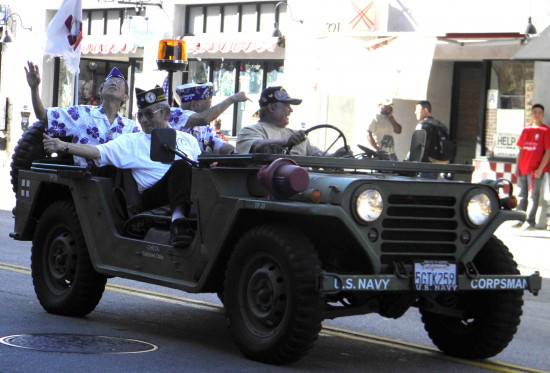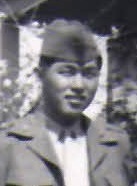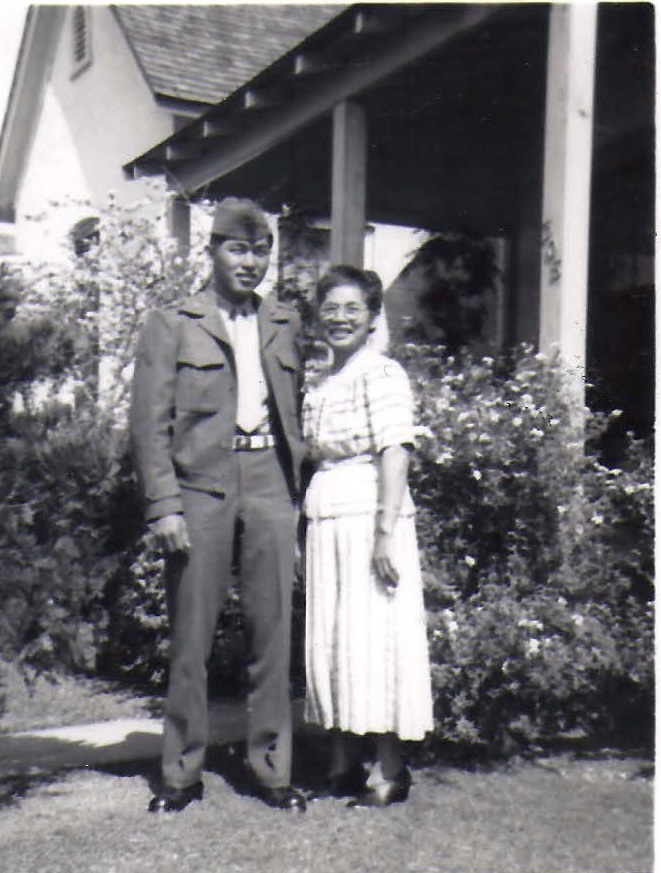※情報提供は、こちらのメールフォームからなでしこアクションまでお願いします
***************************************
日系二世 ロバート 和田 氏
1951年、20歳、米海兵隊志願兵として、死を覚悟して朝鮮半島に向かう
途中寄港した横須賀で出会った花売りの少女とその母親
「私たちはあなたの無事な米国への帰還を祈っています」
その言葉と祈りを信じて 生還できた
今でも目頭が熱くなる
もう一度、会ってお礼を言えたら、、、、、
***************************************
カリフォルニア州ブエナパーク市在住、日系2世の Robert M. Wada(和田)氏が日本人女性を探しておられます。
和田氏は、現在(2013年9月時点)83歳、この度のブエナパーク市の慰安婦像設置反対運動では、その阻止に貢献された方です。
和田氏が反対意見を投書したRafu Shimpo(2013年8月7日付記事)
KOREAN WAR VET SOUNDS OFF ON PROPOSED COMFORT WOMEN MONUMENT
氏はWWⅡ中、12歳の時、日系人収容所で過ごしました。
朝鮮戦争では米海兵隊に志願、1951年の5月から52年の4月までの1年間、朝鮮戦争で戦いました。その時に幼馴染の親友を亡くしています。その後、朝鮮戦争日系在郷軍人会の初代会長も務めました。
***************************************
Robert M. Wada 和田 氏 からのメッセージ
私が横須賀で出合った少女
私は、1951年の5月、米国から釜山へ向かう途中、横須賀に輸送船で寄港しました。当時の横須賀は大変貧しく、街頭には売春婦や物売りが米艦船の周囲に群がっていました。横須賀には米軍兵士は沢山いましたが、海兵隊の軍服で日本人の顔をし、日本語を話す兵士の私は珍しかったと思います。
上陸最初の夜、遊んだ後で船に戻る途中、10歳くらいの少女が造花を海軍基地の入り口で売っているのを見つけました。片手には造花、もう一方の手には沢山のおカネを握っています。もう真夜中近いので、「こんな遅くにここに来てはダメだよ」と言って、残りの造花を全部買い、家まで送ってあげました。
翌日、船に戻る途中の深夜、昨晩の少女がまた同じ場所にいるのを見つけました。私は少女を叱りました。ところがその子は、「ちょっと待って下さい」と日本語で言い、通りを駆けて行って6、7人の婦人集まっているところまで行くと、一人の女性の手を取って急いで戻ってきたのです。
その女性は少女の母親でした。母親は私に昨夜のお礼を言い、「私たちはあなたの無事な米国への帰還を祈っています」と言いました。そして2人は去っていきました。
これだけの話です。でも私はこの名も知らぬ親子の事をずっと忘れられません。
当時20歳だった私は、自分は恐らく戦場から生きては帰れないという恐怖を胸中深く秘めていました。この少女と母親の親切な言葉と祈りを信じることで、私は無事に生還できたのです。
あの晩のことを思うと、今でも目頭が熱くなると言います。そして、今では多分70代になっているであろう、あの少女にもう一度会ってお礼を言いたいと願っているのです。
Robert M. Wada
Sgt., U. S. Marine Corps
Korea, 1951-‘52
※情報提供は、こちらのメールフォームからなでしこアクションまでお願いします

2012年日系ウィークでの日系朝鮮戦争帰還兵のパレード
Members of Japanese American Korean War Veterans in last year’s Nisei Week Parade. (Rafu Shimpo photo)
******************************
<和田氏が書いた、慰安婦記念碑反対のメッセージ>
※原文英語は日本語の下にあります。
慰安婦記念碑反対について 米国各機関 宛て 手紙
差出人:ロバート.M.和田 日付:2013年9月10日
韓国慰安婦像記念碑の承認について
私はブエナパーク在住30年、その前はラ・ミラダに23年間住んでいました。日系二世で、カルフォルニアのレッドランズで生まれ育ち、教育を受けました。
第二次世界大戦中、私が12歳の少年の時、米国西海岸の日系人12万人以上が送られた強制収容所で過ごしました。日系人強制収容所の経験にも関わらず、朝鮮戦争時の1950年、私は米国海兵隊に志願し、米国と私にとって見知らぬ人たちを護る為に戦いました。この戦争で私の大切な親友二人が戦死しました。一人は幼稚園時代からの友達です。今でも彼の死に責任を感じています。日本から移住した私の両親には5人の息子がいますが、皆、米国の戦争に行っています。2人は第二次世界大戦中、陸軍442日系部隊に、私を含め3人は朝鮮戦争に同時に行っています。
私は韓国慰安婦記念碑が米国に建つことに反対ですが、日本を擁護するという意味ではありません。もし慰安婦問題が真実だと証明されれば私も驚きを禁じ得ませんが、この手紙で訴えることで、米国日系人社会の誠実さを守りたいのです。謝罪は日本の責任であり、米国政府機関や、個人は関係ありません。この問題は外国の二国間の問題なのです。
ブエナパーク市議会(2013年7月23日)公聴会をテレビで視ました。まだ若い韓国人が数字や統計を用いて日本の残弱行為を語っていました。日本人強制収容所がいかに酷かったかを聴衆向けに大げさに語る若い世代の日系人とこの韓国人は似ていると思いました。公聴会の登壇者は関係の無い外部の人は除き、地元在住者に限ったほうが良いと思います。
思い出していただきたいのは、第二次世界大戦よりずっと前、オレンジ郡は日系一世、二世の農場でした。韓国人が来る遥か前から、農業を営んでいたのです。第二次世界大戦中の日本の悪行について1900年代初めにこの地に来た日系人一世を責めるのは正当ではありません。カルフォルニア州立大学に日系人農業博物館がありますが、オレンジ郡には記念碑は一つもありません。
慰安婦問題のような論争となっている問題についての記念碑は米国のどの街にも益が無いと思います。これは二国間の問題であり、慰安婦記念碑は問題を更に悪化させ、米国の多様な社会の一部の人達だけが利するものとなります。そうなると、黒人奴隷制記念碑、ヒスパニック移民記念碑、ユダヤ人処刑記念碑、日系人強制収容所記念碑も建てなくてはならないことになるのではないでしょうか。
提案されている慰安婦記念碑は外国の問題についての碑です。朝鮮戦争で命がけで戦った5千人以上の日系人、戦死した256人の日系人の為の碑ではありません。私たちは祖国への愛と韓国の人々の自由の為に戦い死んだのです。韓国人が米国に移住して私達の先人を貶める為に戦ったのではありません。全米には多くの高齢の日系人がいます。彼らも私と同様強く反対していますがそれを表明できないでいることを理解していただきたい。
韓国人は、日本人への憎悪感を、日本国内の日本人に対してだけでなく、米国にも持ち込み、日系人も対象にしています。
2007年、ソウル大学の外国人教授から私にメールが来ました。彼の質問は、「何故、韓国の大学は未だ反日教育をしているのか。日系米国人まで反日の対象にしている。」私は「なぜ日系米国人まで対象にするのか全く分からない」と返信しました。日系人がそのような無礼な扱いを受ける筋合いはありません。韓国人は、日系人が朝鮮戦争で勇敢に戦い、米国にやってくる自由が持てたことを感謝すべきです。
韓国の反日について重要な例外が一つあります。朝鮮戦争の韓国退役軍人は日系退役軍人の犠牲と苦労を理解しており、戦友である日系退役軍人に対して敵意を示すことはまずありません。
1997年、私は朝鮮戦争日系退役軍人会を組織し、最初の4年間、代表を務めました。韓国人と日系米国人の間の憎悪の溝の架け橋となるべく、退役軍人会は韓国政府の許可を得て、北朝鮮との非武装地帯の近くに、朝鮮戦争で戦死した256人の日系軍人の名前を刻んだ記念碑を建てました。記念碑は坡州市の臨津閣(イムジンガク)に建っています。他国の非道を訴える慰安婦記念碑は何の解決にもなりません。坡州市の日系軍人記念碑が築いた良好な関係を傷つけるだけです。
日本と韓国を公正に見て決議して下さい。正義の国際的貢献になります。もし、慰安婦記念碑が建ったとしたら、憎悪の継続と増長で米国日系人が辛い思いをするだけです。
2013年8月29日、カルフォルニアのブエナパーク市議会では同市内に慰安婦像記念碑を建てることに反対を表明したことを最後に加えます。
朝鮮戦争に志願した日系米国人を理解する為に、私の書いた二つの書籍をご紹介します。
「From Internment, to Korea, to Solitude」
「Americans of Japanese Ancestry in the Korean War」
これらの本のタイトルからも朝鮮戦争で韓国の人々の自由を護る為に戦い犠牲となった日系人の役割をお分かり頂けると思います。
ロバート M. 和田
米国海兵隊
朝鮮戦争 1951~1952年
<原文>
My Letter to U.S. Agencies Opposing Korean Comfort Woman Monument
From: Robert M. Wada Date: September 10, 2013
Considering approval of a Korean Comfort Woman Statue Monument
I have been a resident of Buena Park for 30 years and prior to that lived in nearby La Mirada for 23 years. I am a second generation American of Japanese ancestry born, raised and educated in Redlands, California.
As a young boy of 12 years of age, I was a victim of the mass World War II incarceration of over 120,000 Japanese Americans living on the WestCoast of the United States. In 1950 during the Korean War, in spite of my incarceration by the United States Government in WWII, I volunteered for the U.S. Marine Corps to serve, fight and defend a country and a people I did not even know. I lost two very very close friends in the Korean War, one of whom I first met in Kindergarten and to this day still feel responsible for his death. Five sons of my first generation parents from Japan served in the U.S. military in American wars. Two in WWII with the muchdecorated Japanese American 442nd Regimental Combat Team and threeof us were in Korea during the war at the same time..
Although I object to the proposed Korean Comfort Woman monument in any location in the United States, my objection to this monument in no way means I condone or defend the actions of Japan. I too will be appalled if the allegations are proven to be true. However, in this letter I am merely defending the integrity of our Japanese American communities across the nation. An apology is due from Japan, not by governmental agencies in the U.S. nor as individuals. This is an issue between two foreign countries.
After watching and hearing the speakers at a City of Buena Parkhearing on TV, I heard many very young Koreans telling their stories of the atrocities with figures and statistics. In my opinion, they are comparable to younger generation Japanese Americans who speak of the horrible conditions in the internment camps and often exaggerate stories to get their point across to viewers or an audience. I recommend any hearings be restricted to your local residents and not residents from far away outside municipalities, who have no local interest.
I would like to remind you, long before World War II, a very large portion of Orange County was predominantly farms owned and operated by first and second generation Japanese Americans. They were farming long before any Korean people or even before other ancestors set foot in the area. It is not fair to blame our first generation parents who came here as far back as the early 1900’s for atrocities committed by Japan during World War II. There is a Japanese American farming industry museum on the grounds of the California State University in Fullerton and not one monument is erected in any city of Orange County.
In my opinion, I do not feel that a monument for such a controversial issue is in the best interest of any City or anywhere else in the United States. It is a problem between two foreign countries and such a monument only intensifies the divisive issue and only benefits one segmentof people in our very diverse society. Will that mean we can now open the door to additional monuments in your municipality to commemorate the slavery of the blacks, the immigration of the Hispanics, the execution of the Jewish people during WWII and the illegal incarceration and stripping of the constitutional rights of the American citizens of Japanese ancestry during their internment in WW II. ?
This proposed monument is to commemorate a foreign issue and is not what I, nor the well over 5,000 Americans of Japanese ancestry and the256 who gave their lives served and died for. We fought and we died for the love of our country and the freedom of the people of the Republic of Korea, not so ultimately they could migrate to the United States and bring shame to our heritage. I hope you will all realize as well, there are many older residents through out the United States who are not able to express their opposition and, like myself, are adamantly against it.
It is well known throughout the Japanese American communities,there is a hatred exercised here in the United States by the Korean people,not only against the Japanese in Japan, but this hatred has been brought to the United States against the Japanese Americans as well.
In 2007, I received and answered an email from a non-Korean professor at a university in Seoul, Korea. He questioned why the university was still teaching hatred for the Japanese and they even include the Japanese Americans. I responded, “I have no idea why they include Japanese Americans.” The Japanese Americans certainly do not deserve such disrespect or bigoted treatment. The Korean people should be appreciative the Japanese Americans bravely served during the Korean War, which helped grant them the freedom to come to America.
There is one important exception to this hatred. Many of the South Korea War Veterans of the War recognize the sacrifice and suffering of their fellow Japanese American Veterans and show very little animosity toward their fellow Japanese American veterans of the Korean War.
In 1997, I helped organize and was the president the first four years of the Japanese American Korean War Veterans Organization. To try and help bridge that hatred gap between the Korean people and the Japanese Americans, our organization with the permission of the Republic of Korea government built a Memorial near the demilitarized zone between North and South Korea listing each individual name of the 256 Japanese Americans killed in the Korean War. That Memorial is located at Imjin Gak,Paju City in Korea. To allow the Comfort Woman monument for atrocities committed by a foreign country will not bring a local resolution. It will only destroy any positive benefit we may have gained in the past as a result of the Japanese American Veterans’ Memorial in Paju City, South Korea.
I suggest your Agency merely pass a resolution in support of fair justice between Japan and Korea. This would place your Agency on record in aiding international efforts for justice. If this monument is built anywhere within your jurisdiction, it will only enhance and continue the hatred suffered by the Japanese Americans in the United States.
My final comment is to make you aware that on Thursday, August 29, 2013, the City Council of the City of Buena Park, California, setting a precedence, voted to deny the implementation of the Comfort Woman Statue Monument in the City of Buena Park.
There are two books I have authored that may be of interest to help you understand the role of the Japanese Americans who served in the Korean War. The first is my memoir book titled, “From Internment, to Korea to Solitude,” and my second book is titled, “Americans of Japanese Ancestry in the Korean War.” Their titles alone partially define the role of the Japanese Americans in the Korean War who fought and sacrificed their lives to protect the freedom of the people of the Republic of Korea.
Sincerely,
Robert M. Wada
Sgt., U. S. Marine Corps
Korea, 1951-‘52
*******************************
VOX POPULI: Korean War Vet Sounds Off on Proposed Comfort Women Monument
https://rafu.com/2013/08/vox-


雲をつかむような話で、情報提供にはとてもいきませんが、何か方法はないかとちよっと考えてみました。
手がかりは、
(1)10歳ぐらいの少女で造花を海軍基地の入口で売っていた
(2)家まで送ってあげた
という2点。
①まず(1)から現在年齢は「多分70代であろう」ということ。
②次に「造花」を売っていたことから、当時米軍関係者にそれなりの「造花」に需要があったということですね。
それが証拠に「一方の手には沢山のおカネを持っていた」とのこと。多分、米軍兵士が女性に贈ったり、出征する兵士に家族が分かれ際に贈ったりしていたのかもしれません。
ここで少女は、当時どこからか「商品となる造花」を仕入れいたはずです。そこで、yahoo地図で横須賀基地周辺の造花店を検索したら、「西村造花店」というのがありました。現在の横須賀駅から数キロの近くです。これなら歩いていける距離です。
最もこの店が朝鮮戦争の頃からあったのかどうかどうかわかりません。なお、現在この店は造花というより「葬儀」の仕事が主流のようです。
西村造花店の情報はこちらです。
http://loco.yahoo.co.jp/place/1843d1289ab6ddf0ccdfd9eeea543055913e832c
この少女はこの西村造花店の関係者の可能性もありです。
③「家まで送ってあげた」ということから、徒歩で行ける海軍基地周辺の住民であったと考えれます。
従って、基地周辺の都市開発などで住居移転などしていなければ、御兄弟かそのまま本人がご在住の可能性が十分考えられます(但し結婚で本人の居住地は変わっている可能性あり)。
そこで、和田氏から「送った時間」などの情報が得られば、徒歩距離を見積もって海軍基地周辺のどの地域か推定できる可能性があります。
以上から、調査方法として例えば以下のようなことが考えられないでしょうか?
①和田氏から「送った時間」などを教えてもらい、海軍基地周辺のどの地域が居住地だったか推定する。
②西村造花店に当時の状況を問い合わせる。
この他に、③横須賀市へ依頼して市の広報誌に「人探し」ということで広報してもらえないか依頼する。
(市ではなくその地域のローカルな広報誌或いはブログがあるかもしれません)
http://maps.loco.yahoo.co.jp/maps?p=%E6%A8%AA%E9%A0%88%E8%B3%80%E9%A7%85&lat=35.284256930208045&lon=139.65484060080658&ei=utf-8&datum=wgs&lnm=%E6%A8%AA%E9%A0%88%E8%B3%80%E9%A7%85&idx=25&v=2&sc=3&layer=4&uid=81954666222d63487d7df2b297f2110cb9a39d46&fa=ids